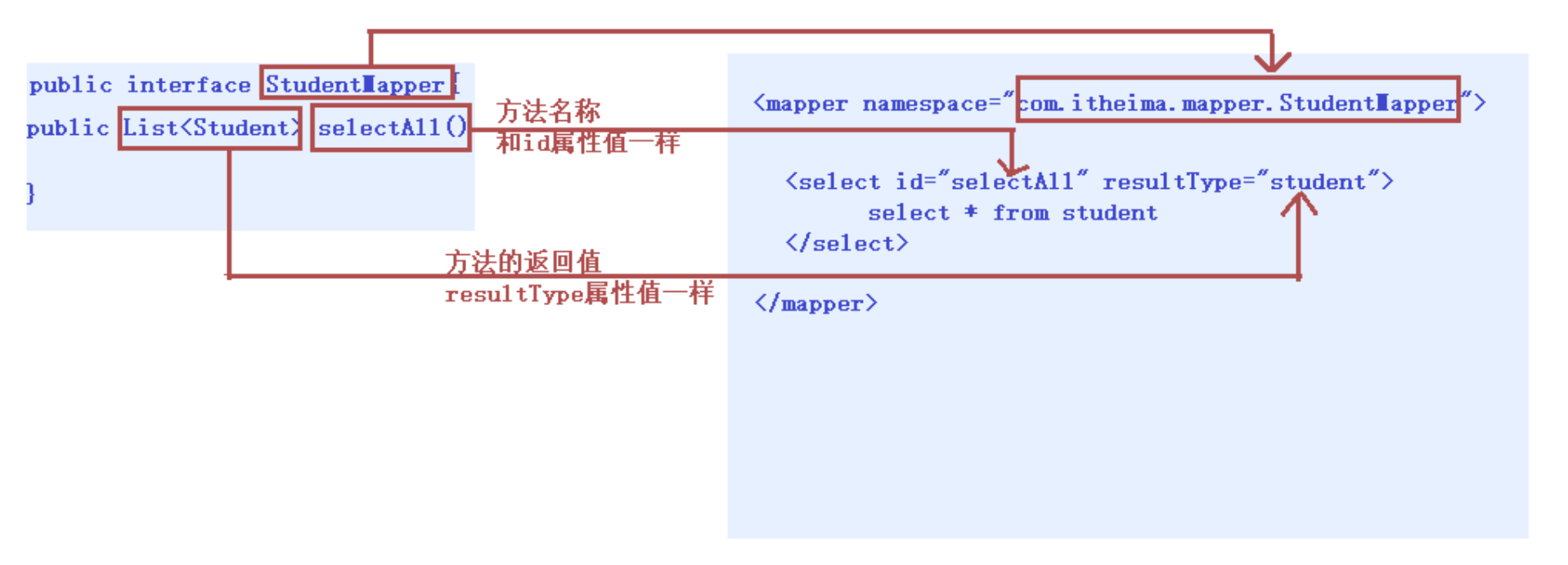📦博主主页:楠羽
🏆简介:一个大二的科班出身,主要研究 Java 后端开发
⏰座右铭:成功之前我们要做应该做的事情,成功之后才能做我们喜欢的事
💕 过客的你,可以给博主留下一个小小的关注吗?这是给博主最大的支持。以后博主会更新大量的优质的作品!!!!
一.接口代理方式实现 Dao
1.1 代理开发方式介绍
采用 Mybatis 的代理开发方式实现 DAO 层的开发,这种方式是我们后面进入企业的主流。
Mapper 接口开发方法只需要程序员编写 Mapper 接口(相当于 Dao 接口),由 Mybatis 框架根据接口定义创建接口的动态代理对象,代理对象的方法体同上边 Dao 接口实现类方法。
Mapper 接口开发需要遵循以下规范:
1) Mapper.xml 文件中的 namespace 与 mapper 接口的全限定名相同
2) Mapper 接口方法名和 Mapper.xml 中定义的每个 statement 的 id 相同
3) Mapper 接口方法的输入参数类型和 mapper.xml 中定义的每个 sql 的 parameterType 的类型相同
4) Mapper 接口方法的输出参数类型和 mapper.xml 中定义的每个 sql 的 resultType 的类型相同
总结:
接口开发的方式: 程序员只需定义接口,就可以对数据库进行操作,那么具体的对象怎么创建?
1.程序员负责定义接口
2.在操作数据库,mybatis 框架根据接口,通过动态代理的方式生成代理对象,负责数据库的 crud 操作
1.2.编写 StudentMapper 接口
1.3 测试代理方式
public Student selectById(Integer id) { Student stu = null; SqlSession sqlSession = null; InputStream is = null; try{ //1.加载核心配置文件 is = Resources.getResourceAsStream("MyBatisConfig.xml");
//2.获取SqlSession工厂对象 SqlSessionFactory sqlSessionFactory = new SqlSessionFactoryBuilder().build(is);
//3.通过工厂对象获取SqlSession对象 sqlSession = sqlSessionFactory.openSession(true);
//4.获取StudentMapper接口的实现类对象 StudentMapper mapper = sqlSession.getMapper(StudentMapper.class); // StudentMapper mapper = new StudentMapperImpl();
//5.通过实现类对象调用方法,接收结果 stu = mapper.selectById(id);
} catch (Exception e) {
} finally { //6.释放资源 if(sqlSession != null) { sqlSession.close(); } if(is != null) { try { is.close(); } catch (IOException e) { e.printStackTrace(); } } }
//7.返回结果 return stu; }
复制代码
1.4 源码分析
分析动态代理对象如何生成的?
通过动态代理开发模式,我们只编写一个接口,不写实现类,我们通过 getMapper() 方法最终获取到 org.apache.ibatis.binding.MapperProxy 代理对象,然后执行功能,而这个代理对象正是 MyBatis 使用了 JDK 的动态代理技术,帮助我们生成了代理实现类对象。从而可以进行相关持久化操作。
分析方法是如何执行的?
动态代理实现类对象在执行方法的时候最终调用了 mapperMethod.execute() 方法,这个方法中通过 switch 语句根据操作类型来判断是新增、修改、删除、查询操作,最后一步回到了 MyBatis 最原生的 SqlSession 方式来执行增删改查。
1.5 知识小结
接口代理方式可以让我们只编写接口即可,而实现类对象由 MyBatis 生成。
实现规则 :
映射配置文件中的名称空间必须和 Dao 层接口的全类名相同。
映射配置文件中的增删改查标签的 id 属性必须和 Dao 层接口的方法名相同。
映射配置文件中的增删改查标签的 parameterType 属性必须和 Dao 层接口方法的参数相同。
映射配置文件中的增删改查标签的 resultType 属性必须和 Dao 层接口方法的返回值相同。
获取动态代理对象 SqlSession 功能类中的 getMapper() 方法。
二. 动态 sql 语句
2.1 动态 sql 语句概述
Mybatis 的映射文件中,前面我们的 SQL 都是比较简单的,有些时候业务逻辑复杂时,我们的 SQL 是动态变化的,此时在前面的学习中我们的 SQL 就不能满足要求了。
2.2 动态 SQL 之<if>
我们根据实体类的不同取值,使用不同的 SQL 语句来进行查询。比如在 id 如果不为空时可以根据 id 查询,如果 username 不同空时还要加入用户名作为条件。这种情况在我们的多条件组合查询中经常会碰到。
如下图:
<select id="findByCondition" parameterType="student" resultType="student"> select * from student <where> <if test="id!=0"> and id=#{id} </if> <if test="username!=null"> and username=#{username} </if> </where></select>
复制代码
当查询条件 id 和 username 都存在时,控制台打印的 sql 语句如下:
… … … //获得MyBatis框架生成的StudentMapper接口的实现类 StudentMapper mapper = sqlSession.getMapper( StudentMapper.class); Student condition = new Student(); condition.setId(1); condition.setUsername("lucy"); Student student = mapper.findByCondition(condition); … … …
复制代码
当查询条件只有 id 存在时,控制台打印的 sql 语句如下:
… … … //获得MyBatis框架生成的UserMapper接口的实现类 StudentMapper mapper = sqlSession.getMapper( StudentMapper.class); Student condition = new Student(); condition.setId(1); Student student = mapper.findByCondition(condition);… … …
复制代码
总结语法:
<where>:条件标签。如果有动态条件,则使用该标签代替 where 关键字。<if>:条件判断标签。<if test=“条件判断”> 查询条件拼接</if>
复制代码
2.3 动态 SQL 之<foreach>
循环执行 sql 的拼接操作,例如:SELECT * FROM student WHERE id IN (1,2,5)。
<select id="findByIds" parameterType="list" resultType="student"> select * from student <where> <foreach collection="array" open="id in(" close=")" item="id" separator=","> #{id} </foreach> </where></select>
复制代码
测试代码片段如下:
… … … //获得MyBatis框架生成的UserMapper接口的实现类StudentMapper mapper = sqlSession.getMapper(StudentMapper.class);int[] ids = new int[]{2,5};List<Student> sList = mapper.findByIds(ids);System.out.println(sList);… … …
复制代码
总结语法:
<foreach>:循环遍历标签。适用于多个参数或者的关系。 <foreach collection=“”open=“”close=“”item=“”separator=“”> 获取参数 </foreach>
复制代码
属性 collection:参数容器类型, (list-集合, array-数组)。open:开始的 SQL 语句。close:结束的 SQL 语句。item:参数变量名。separator:分隔符。
2.4 SQL 片段抽取
Sql 中可将重复的 sql 提取出来,使用时用 include 引用即可,最终达到 sql 重用的目的
<!--抽取sql片段简化编写--><sql id="selectStudent" select * from student</sql><select id="findById" parameterType="int" resultType="student"> <include refid="selectStudent"></include> where id=#{id}</select><select id="findByIds" parameterType="list" resultType="student"> <include refid="selectStudent"></include> <where> <foreach collection="array" open="id in(" close=")" item="id" separator=","> #{id} </foreach> </where></select>
复制代码
总结语法:
我们可以将一些重复性的 SQL 语句进行抽取,以达到复用的效果。
- <sql>:抽取 SQL 语句标签。 - <include>:引入 SQL 片段标签。 <sql id=“片段唯一标识”>抽取的 SQL 语句</sql> <include refid=“片段唯一标识”/>
复制代码
2.5 知识总结
MyBatis 映射文件配置:
<select>:查询
<insert>:插入
<update>:修改
<delete>:删除
<where>:where条件
<if>:if判断
<foreach>:循环
<sql>:sql片段抽取
复制代码














评论